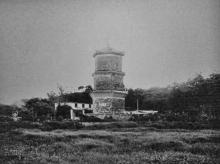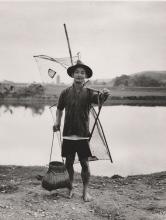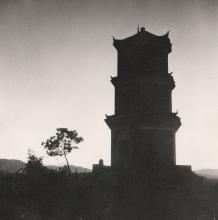(We're looking for any photos / contemporary descriptions of the pagoda from the 1940s or earlier, to help identify a photo's location. If you know of any, please let us know in the comments below.)
Notes from the AMO's website:
Tsui Sing Lau Pagoda (Pagoda of Gathering Stars) is the only surviving ancient pagoda in Hong Kong. According to the genealogy of the Tang clan of Ping Shan, the pagoda was built by Tang Yin-tung, the seventh generation ancestor, more than 600 years ago. This hexagonal-shaped pagoda is a three-storey green-brick structure about thirteen metres high. A statue of Fui Shing (Champion Star) is worshipped on the upper floor. The pagoda was built to improve fung shui of the locality in order to prevent flooding disasters to the village. Furthermore, it was believed that its auspicious location, which is in alignment with Castle Peak, would ensure success for clan members in the Imperial Civil Service Examinations. In fact, the Tang clan of Ping Shan has produced numerous scholars and officials.
Tsui Sing Lau Pagoda was declared a monument on 14 December 2001.



Comments
Mention in HKGRO
I searched for pagoda in HKGRO. There are many results, but the only one I found that mentions this pagoda is from 1916, and gives a good idea of the surroundings at that time:
http://sunzi.lib.hku.hk/hkgro/view/G1916/48485.pdf
The notice is about the sale of a plot of land in the area. The land was on the sea-shore, and was intended to be reclaimed and converted into agricultural land. There were two main water channels passing across the land, which were used for water transport at the time:
Land Office.
No. S. 11.-It is hereby notified that the following Sale of Crown Land by Public Auction will be held at the Police Station, Au Tau, at 12 Noon, on Thursday, the 20th day of January, 1916.
The Lot is sold for the term of Seventy-five years from the 1st day of July, 1898, with the right of renewal for a further term of 21 years less 3 days at a re-assessed Crown Rent as an Agricultural Lot subject to the General Conditions of Sale published in Government Notification No. 365 of 1906 and to the Special Conditions hereunder specified.
PARTICULARS OF THE LOT.
Registry No. Locality. Contents in Acres. Upset Price. Annual Crown rent.
No. D. D. Lot. N. S. E. W.
$
I 126 665 Ping Shan. 1,211.87 12,120 $15 for the first five years and $1,212 there-after subject to re-assessment.
SPECIAL CONDITIONS.
1. No building shall be erected on the Lot other than such as may in the opinion of the Land Officer be necessary for the proper occupation of the Lot as agricultural land. For all land occupied by such buildings, whenever erected, the purchaser shall pay additional premium at the rate of one cent per square foot and Crown Rent at the rate of $50 per acre per annum.
2. The purchaser shall within five years from the date of sale construct a bund on the seaward side of the Lot in such position, in such manner and of such material as the Land Officer may approve and generally to his satisfaction in every respect and shall maintain the same in good order, condition and repair to the satisfaction of the said Land Officer during the whole period for which the Lot is sold.
3. The purchaser shall within five years from the date of sale reclaim and convert the land into agricultural land to the satisfaction of the Land Officer.
4. After the expiration of the said five years, the purchaser shall not, during the remainder of the term for which the Lot is sold permit or allow the land to remain uncultivated according to the custom of the country for a period of five consecutive years and a covenant to that effect shall be inserted in the Crown Lease of the Lot.
5. The Crown Rent mentioned in the Particulars of sale is subject to re-assessment at the end of the first twenty-five years from the date on which the Lot is sold, and thereafter rent at a rate of not exceeding $2 an acre shall be paid, as is deemed fair and reasonable by the Surveyor to His Majesty the King or by such other person as shall be appointed by the Governor of Hongkong for that purpose, and a special proviso to that effect shall be inserted in the Crown Lease of the Lot.
6. The purchaser shall not have or be entitled to any right of access to the sea or to any right of access to any water which may be near the Lot or on which the same abuts or to any compensation whatever in the event of any reclamation being made between any part of the Lot and such sea or water and a special proviso to that effect shall be inserted in the Crown Lease of the Lot.
7. The Lot is sold subject to the right of the public at all times to load and unload any kind of vessel on and along the bund referred to in Condition No. 2 and to land, cross and recross the said bund with any goods and other articles at such points as may in the opinion of the Land Officer be necessary and subject also to the right of the public at all times to travel on boats or other vessels and with or without any goods or articles along the two main channels of water flowing through the said Lot.
8. The purchaser shall not divert nor fill in any creek, stream or channel within the Lot without the permission of the Land Officer.
9. The purchaser shall at all stages of the tide maintain in the two existing main channels flowing through the Lot a depth of six feet of water to the existing wooden bridge at Ha Tsun and to the pagoda known as Man Kok at Ping Shan.
10. The purchaser shall not interfere with the navigation of any boat or other vessel in the aforesaid two channels within the Lot.
11. The purchaser shall make proper provision for the discharge of all surplus water from the. Lot in such a manner as to prevent flooding or other damage to adjoining or neighbouring lands.
12. The purchaser shall have no right to any water flowing through any portion of the Lot.
13. The purchaser shall immediately after the date of sale of the Lot pay the sum of $300 to the lessee of Oyster Bed No. 1 as compensation for the removal of the oysters within the Lot. No oysters shall be removed or caused to be removed without the permission of the Land Officer.
G. H. Wakeman,
Land Officer.
14th January, 1916.
When I read "the pagoda known as Man Kok at Ping Shan" I thought it was another name for the pagoda, which might uncover other sources. But this book (http://books.google.com.hk/books?id=AT0RAwAAQBAJ&pg=PA86&lpg=PA86&dq=ma…) says that "Man-Kok" is just a descriptive term that identifies the type of pagoda:
Besides pagodas, there are temple towers in China called Man-Kok, which are erected for the purpose of exercising a good geomantic influence over the localities adjacent. In the uppermost story of such temples there is generally an idol in honour of Man-Chang, the god of learning, before which the youths of the neighborhood go through various ceremonies so as to obtain great success at the literary examinations. These temple towers are very numerous in the province of Kwang-tung, and more particularly in the the large and thickly populated island of Honam at Canton. The highest structure of this kind which I have seen is at the village of Wang-kong-kew. At the time of my visit (in 1868) it was quite new, having been built in 1866.
Mention in "Rambles in Hong Kong"
The book "Rambles in Hong Kong" by G S P Heywood mentions the pagoda in chapter 9:
Ping Shan village is close to the road between Castle Peak and Yuen Long, about a mile and a half short of the latter. A sign board indicates the path to the village, which is out of sight of the road behind the hill on which the police station stands. It is a prosperous-looking little town, with several large houses built around shady courtyards, and a pagoda—the only old one in the Colony, as far as I know. This is an unpretentious little three-storied affair, with ladders leading up inside from one floor to the next, and narrow windows from which you can survey the country round.
The copy I'm looking at is an annotated reprint from 1992, borrowed from the public library. The preface to the 1992 reprint explains the history of the original book:
It's now fifty-four years since the first edition of Rambles was published in December 1938. [...] The book was a revised and expanded version of a series of articles Graham wrote for the Hong Kong Naturalist magazine between May 1935 and December 1936.
Most copies of both the book and the magazine were lost during the war years, and so after the war, he updated and reissued the book to take account of some of the changes around him. The second edition, published in 1951, was written with the first edition in front of him for inspiration. As a result, he left many sections and sentences unchanged from the first edition, while rewriting others. [...]
It is very likely that the description of the pagoda as "an unpretentious little three-storied affair" dates back to Hewyood's first edition in 1938. If anyone has a copy of the first edition, please can you confirm?
Regards, David
PS Copies of the original articles in the Hong Kong Naturalist magazine can be read online at http://hkjo.lib.hku.hk/exhibits/show/hkjo/home but unfortunately they don't mention Ping Shan.
Re: Rambles in Hong Kong 2nd Edition (1951)
Hi David,
Just check the Library with the new My LIbrary Mobile App and found the Central Library has two copies of it in the Reference Collection. They are not on the racks, however. You have to go to the counter to make a request for it.
Thanks & Best Regards,
T
Re: Rambles in Hong Kong 2nd Edition (1951)
Hi T,
Thanks for checking these. The text in the 1992 reprint is a copy of the text from the 1951 second edition, so there won't be any extra information there. I'd still be interested to hear what he wrote about the pagoda in the 1938 1st edition if anyone has a copy.
Regards, David
history
Tsui Sing Lau in yuen long is the only ancient pagoda in Hong Kong that still exists. It is believed to be built by Tang yen tone of the seventh generation of the prominent Tang family there in 1486. It has a hexagonal shape and 3 storeys. The top storey is dedicated to the worship of the "文魁星" or star of knowledge or more exactly number one in exam. "Tsui Sing" simply means attracting the star. The star god would help students to be successful in public examinations. In ancient China, it was the only way to become government officials for ordinary folks with no money and connections. Many Hong Kong residents took part in these examinations until the end of the Qing dynasty. Some even travelled north to Canton where exams at a higher level took place. The highest level exam was in Beijing in the palace in front of the emperor.
source : 梁操雅, 羅天佑 - 香港考評文化的承與變 從強調篩選到反映能力
https://new.gwulo.com/media/43048